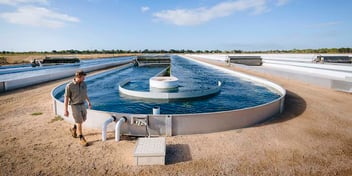The next agricultural revolution: How robotics will help us feed our growing population
Australia’s population is projected to reach 37 million in 2050 – a 60% increase from current numbers. That’s a lot of people to feed, but the country’s agriculturalists might be getting more and more help from a new source: robots and artificial intelligence (AI).
“There’s a wave of technical disruption and change that’s coming to agriculture that will see us meet the challenge of feeding a growing population across the globe,” said Campbell Newman, director of Arcana Capital and keynote speaker at the upcoming Where the Waters Meet 2018 Tasmania Annual Conference.
Newman has previously held the role of Premier of Queensland from 2012-15, and prior to that he was Lord Mayor of Brisbane from 2004-11. During both these tenures, he oversaw a suite of ambitious infrastructure projects and reform aimed at revitalising industry and kickstarting the economy.
According to him, the use of robotics and AI in agriculture is a part of the ‘green revolution’ that has been happening since the end of World War Two.
“We’ve seen huge increases in food production and productivity because of the deployment of agricultural chemicals and fertilisers, plant breeding and GMOs. We’ve also seen since then the use of very large machines – bigger and bigger machines covering more hectares per unit of labour per day,” Newman said.
“All that’s come together to see a massive increase in the production of food. What’s about to happen is that the introduction of robotics technology will take us to the next level.”
Using robotics and AI in agriculture comes with “all sorts of promises”, he added, largely due to their targeted nature. A robot equipped with AI can apply fertiliser precisely where it’s needed, water only the plants that are thirsty, zap individual weeds while sparing the rest of the field and pick crops at peak freshness.
Benefits include increased production per hectare of land and reduced need for chemicals, pesticides, herbicides and fertilisers, which then offers greater protection for catchments due to less runoff.
On top of that, the smaller size of agricultural robots compared to large, heavy machinery gives them an advantage, Newman said. Because they are smaller and lighter, they can better prevent soil erosion and compaction.
“Instead of big, bulky machines we see a vision of small, lightweight, low-cost machines working together in swarms to grow crops more effectively,” he said.
Most of the agricultural robots on the market are autonomous ground vehicles about the size of a small four-wheel drive capable of performing a range of tasks, but there are also some companies looking at drone technology as well.
But beyond crop monitoring applications, Newman said there are other potential uses for this technology.
“For example, large-scale agricultural irrigation schemes, where they have many kilometres of of irrigation channels, there’s an ongoing job to deal with vegetation along the banks to keep it cut back or to kill aquatic weeds – you can have a machine doing that work,” Newman said.
“But in terms of the use of irrigation water, the deployment of agricultural robots will take us to a situation where we dramatically reduce the amount of water. You’re deploying the water exactly where it’s required to the root system and you’re only using the right amount of water.”
The sky is the limit, though, in how this technology can be applied in the water industry. While Newman had primarily focussed on agricultural applications, he said autonomous robots can be used for jobs such as asset maintenance, measuring water quality, coastal monitoring and more.
“You can apply this style of technology to almost any other area of the water industry,” he said.
Watch Campbell Newman's keynote address at the Where the Waters Meet 2018 Tasmania Annual Conference:
https://www.youtube.com/watch?v=Dtk-5muWWf4&t=1008s

